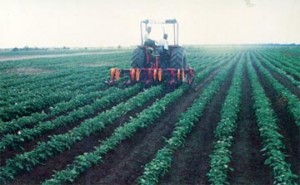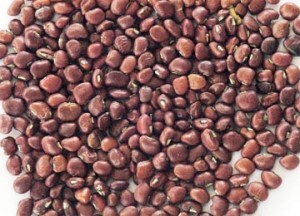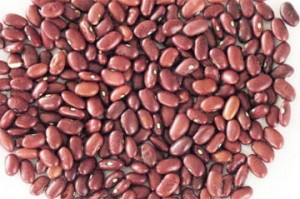Assessing the agricultural significance of Guyana’s Minica 4 Red Pea
Rowland Fletcher – Agronomist
The Minica 4 Red Pea is a small to medium sized pulse or legume with a dark reddish brown testa similar in color to the red kidney bean. It is a bush-type cowpea, which has demonstrated a hardiness and adaptability across a range of environmental conditions in Guyana. Minca 4 has played a vital role in savannah farming systems, and has been the main crop among small farmers in the Upper Berbice River savannahs for the past two decades.
A random survey of the food stores and markets around the country will reveal erratic supplies and high prices for our own home-grown Minica 4 Red Pea which, arguably, was one of the early successes of Guyana’s agricultural diversification efforts. Compared with the prevailing prices of the other legume staples, most of which are imported, we find an almost times 2 price differential as well as a VAT- free advantage for the imports. The current high price and short supply of red peas is an indication of disenchantment among local farmers with what they consider to be unfair external competition plus the additional burden of spiraling costs of fertilizer and other production inputs. Apart from problems associated with pricing and marketing the Red Pea is experiencing an economies of scale default resulting in fewer producers and lower acreages.
The gates are open locally for further external competition in the form of imported substitutes. Already, a well-packaged and high quality equivalent product from Central America has appeared in at least one popular urban supermarket at a price that competes with that of the local product.
The history of Minica 4 dates back to the early 1980’s when collaborative work between the Inter American Institute for Cooperation on Agriculture (IICA) and the Ministry of Agriculture, through a programme of field trials and validation tests, selected this cultivar from a batch of cowpea germ plasm material introduced from the International Institute for Tropical Agriculture in Nigeria. The search was for a companion to the locally grown California 5 blackeye pea, which performed well under moderately dry conditions, but which could not withstand rainfall and high night-time humidity during crop maturity and fell victim to severe pod rot. Minica 4 proved resistant and in addition to its high yielding capacity (1600kg/ha in controlled environment field trials) it was accepted on the local market.

The name Minica 4 was adopted in consideration of the two agencies responsible for the field testing – MIN for the Ministry of Agriculture and ICA for the International Institute for Cooperation on Agriculture. The subscript 4 was the official accession number of that particular cultivar.
The one major concern about Minica 4 is its indeterminate growth habit under sustained high soil moisture as the plant approaches maturity. Under such conditions it would continue rank vegetative growth and vineing, which condition complicates the process of combine harvesting on large-scale commercial acreages. This, however, is not considered a problem for smaller acreages harvested by hand.
Ten years ago the Upper Berbice River farming district, including the Intermediate Savannahs, was the leading local producer of Minica 4 Red Pea, with a collective annual acreage of over 250 ha and a production capacity of 150,000kg of dried peas primarily for the local market. Other coastal and hinterland farming areas were also producing red pea, albeit in smaller quantities and on less substantial acreages. The Upper Berbice River red pea thrust was supported by large scale mechanized savannah investors growing 20 to 80 ha of crop per annum, and the 30 to 40 Berbice River savannah farmers who farmed substantially smaller acreages, primarily by hand, but collectively made a significant contribution to the total annual output.


An interesting marketing scenario developed during that period of simultaneous small scale and large-scale production. Large scale mechanized farmers brought their crop to market at a significantly lower pric, virtually forcing the smaller farmers out of the market at peak harvest periods. Some enterprising small farmers attempted to store their crop for a few months until the glut subsided. However, in addition to the risk of spoilage, this approach was attended by additional storage costs as well as costs associated with protection from post-harvest pests.
In order to accommodate small farmers, one large-scale producer actually phased out red pea from his enterprise portfolio so that the small farmers could enjoy a fairer share of the local market. His quest for overseas marketing opportunities at that time were unsuccessful, however such an initiative might well be worth pursuing given the current global food crisis.
In spite of the vagaries of Red Pea production, the crop is considered a vital component of any integrated commercial production system targeting the Intermediate Savannah environment. In a study conducted during the Intermediate Savannahs Project in 2001, a proposed agricultural development plan for the Wiruni Savannahs offers a red pea production guide for small farmers. The guide emphasizes the absolute necessity for the use of limestone and compound fertilizer in the soil conditioning process, as well as the importance of a good integrated soil management / weed control programme on soils which have been repeatedly cropped. Based on two crops per year, the farmer can expect a 30% economic internal rate of return (IRR). Hand -harvested fields will ratoon (give a second bearing) which. if adequately managed, can yield up to 50% of the original crop. The enterprise productivity in such a system would be significantly higher, and economically justifiable for the pioneering savannah farmer.
The cultivation of cover crops and companion crops within fruit orchards is an essential feature of the soil management system designed for successful farming of savannah soils. In other words, integrated mixed enterprise farming is a sine qua non for successful commercial farming in the savannahs. The agronomic advantages are rooted in the long-term environmental benefits of soil conservation and land productivity. The main economic advantages would include early and continuous revenue flows and efficiency in use of fertilizer and other inputs. Long-term benefits will accrue to soil productivity through the elements of cover cropping and rotations.
Minica 4 red pea has proven to be an excellent cover crop for the Intermediate savannah environment, due to its adaptability, drought tolerance, and vigorous growth in high soil moisture conditions.
In an on-farm validation involving the intercropping of young citrus trees (orange) with a short term crops, including Minica 4. the conclusions were that this practice stimulated the early growth of the citrus and initiated flowering as much as one year earlier than the non intercropped orchards. The system also allowed the farmer to realize a positive cash flow from his enterprise mix by the end of the second year of activity, as compared to the fourth or fifth year in a system, which was not intercropped. Red pea can also be rotated with grass pastures, which might have become weedy and unproductive after years of grazing. Herein lies the intrinsic value of the red pea to the savannah farmer and agribusiness investor.
A more detailed consideration of intercrops, companion crops and rotation systems will follow in a subsequent article on savannah agriculture.




